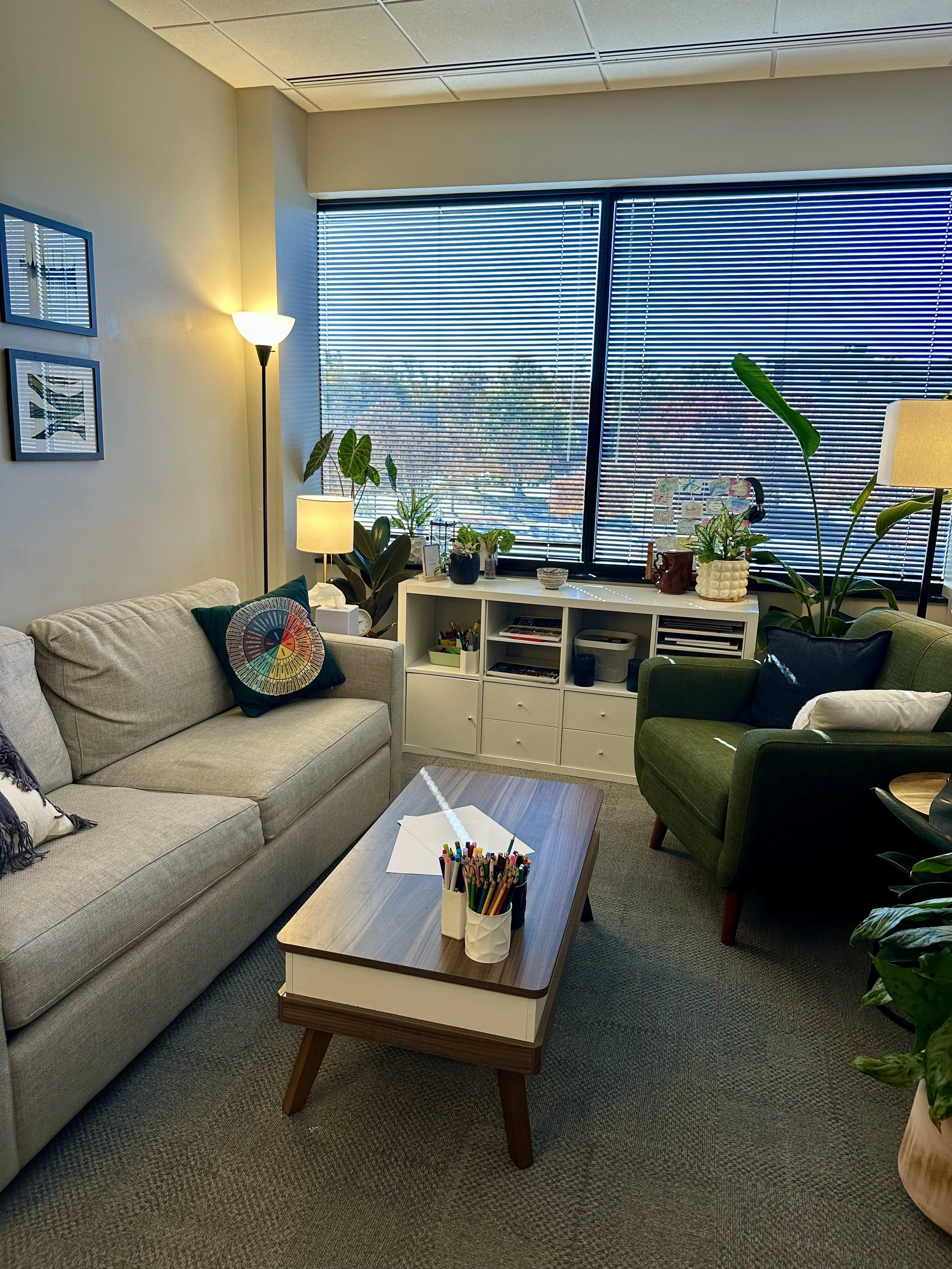What to Expect in Your First Therapy Session
Taking the First Step
Reaching out for therapy can be a big decision filled with emotions and questions. Many of my clients describe feeling both anxious and relieved when we begin our first session and often say they are unsure of what to expect or what they “need to be prepared for.” In my practice, our first session is about getting to know each other, connecting, and exploring our path forward and goals.
I strive to create a space where you can breathe a little easier, where you can let your guard down, where you can be fully open and honest. You don’t need to prepare anything or know exactly what to say. We’ll start wherever you are, together.
Setting the Tone: A Space That Feels Safe and Grounded
Whether we meet in-person or online, I want our time together to feel grounding and warm. In my Reston, VA office, you’ll find natural light, soft textures, my growing house plant collection, and art materials readily accessible. If we meet virtually, I invite you to bring a cup of tea, a cozy blanket, your favorite art supplies, or anything that helps you feel settled.
As a trauma-informed therapist, my work begins with safety and connection. My intake sessions are not structured as a clinical interview like you might have experienced in the past; instead I frame our first session as a conversation built at your pace and centered around your story.
What Happens During the First Session
1. Getting Settled
We’ll begin with a few minutes to check-in and orient to the space and each other: getting comfortable, settling into the here and now, silencing notification. I’ll share a bit about who I am and how I approach therapy through a blend of traditional talk therapy, narrative therapy, EMDR, and Art Therapy.
2. Understanding What Brings You Here
I like to ground our first session in what motivated you to reach out for support now. Some people start by describing a recent struggle or triggering event; others tell a longer story or aren’t sure where to begin. Wherever you are, we’ll follow your lead.
3. Exploration
I’ll follow your lead, but support you by asking some gentle guiding questions. We will explore your reason for coming to therapy in more depth, and how it connects to your past or future. We’ll also explore things like your family history, your support system, relationship history, mental health symptoms, current coping patterns, thinking patterns, eating habits, your daily routines, and trauma history. You are in control of our conversation. We don’t need to discuss anything that feels uncomfortable or anything that seems like too much.
3. Practical Foundations
We’ll also review the basics: confidentiality, session length, payment, and scheduling. I’ll answer any questions about how therapy works, documentation, reimbursement from insurance, etc.
The first session isn’t meant to solve everything or to provide full treatment; it’s meant to begin building a relationship that can support the work of therapy.
How You Might Feel Afterward
Many clients leave their first session feeling lighter, seen, or quietly reflective. Sometimes, emotions rise to the surface once the space feels safe enough. It’s also normal to leave feeling unsure or tired or even a little raw. That’s okay, too. I usually encourage clients to prioritize self-care (rest, nourishing meals, connection) for the rest of the day.
Therapy asks us to slow down and listen inwardly, which can stir up a lot of the things we’ve tried to keep in boxes. Healing happens gently and at your pace. You’re always in control of what you share and how deeply we go.
My Approach: Integrative & Creative Healing
At the heart of my practice is the belief that healing is a collaborative process. Through the integration of traditional therapeutic techniques and creative modalities like art therapy, I aim to meet you where you are and tailor our work to your unique needs. Together, we’ll uncover the path that feels right for you
I draw from multiple approaches. These include EMDR, Art Therapy, Narrative Therapy, CBT, and Somatic awareness .
Art therapy is always optional, but it can offer a valuable second language for your emotions or another lens to look at life through. You don’t need to be an artist or have any art skill, we can start with scribbles and stick figures.
Whether you’re navigating perinatal anxiety, postpartum depression, birth trauma, an eating disorder, body image concerns, or the lingering effects of trauma, our work will center on you.
It’s not about your diagnosis, a structured treatment modality, or the expectations of society or others. Together, we’ll create a space where your voice and vision of wellness guide the journey.
What Comes Next
After your first session, we’ll talk about next steps. Some clients like to set specific goals right away, while others need time to find their rhythm. Over the next few sessions, we’ll identify themes, practice grounding tools, and begin deeper work; whether that’s EMDR preparation, art-based processing, or exploring patterns that have kept you stuck.
Therapy is a collaborative process. I’ll regularly check in about what feels helpful and what might need adjusting.
An Invitation to Begin
Beginning therapy is a decision to care for your own healing. You don’t have to have the right words or know exactly what you need. You just have to show up.
If you’re ready to take that first step, I’d be honored to walk beside you.
Schedule a Consultation
